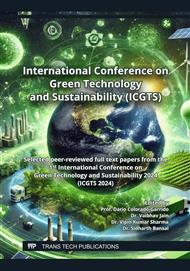[1]
R.C. Singh, R. Chaudhary, and V.K. Sharma, Fabrication and sliding wear behavior of some lead-free bearing materials. Mater. Res. Express, vol. 6, no. 6, p.66533, (2019).
DOI: 10.1088/2053-1591/ab0be4
Google Scholar
[2]
V.K. Sharma, R. C. Singh, and R. Chaudhary, Study of Starting Friction during the Running of Plain Journal Bearing under Hydrodynamic Lubrication Regime. SAE Tech. Pap., vol. 2018-April, p.1–5, (2018).
DOI: 10.4271/2018-01-0838
Google Scholar
[3]
S. Chaudhary, R. C. Singh, and R. Chaudhary, Experimental Investigation of Influence of SiO2 Nanoparticles on the Tribological and Rheological properties of SAE 40 Lubricating Oil. Int. J. Eng. Technol., vol. 9, no. 6, p.4307–4314, (2017).
DOI: 10.21817/ijet/2017/v9i6/170906123
Google Scholar
[4]
M. B. Alang, M. K. Ndikontar, Y. M. Sani, and P. T. Ndifon, Synthesis and Characterisation of a Biolubricant from Cameroon Palm Kernel Seed Oil Using a Locally Produced Base Catalyst from Plantain Peelings. Green Sustain. Chem., vol. 08, no. 03, p.275–287, (2018).
DOI: 10.4236/gsc.2018.83018
Google Scholar
[5]
C. M. Agu, M. C. Menkiti, J. T. Nwabanne, and O. D. Onukwuli, Comparative assessment of chemically modified Terminalia catappa L. kernel oil samples – A promising ecofriendly transformer fluid. Ind. Crops Prod., vol. 140, no. August, p.111727, (2019).
DOI: 10.1016/j.indcrop.2019.111727
Google Scholar
[6]
A. U. Ofoefule, C. Esonye, O. D. Onukwuli, E. Nwaeze, and C. S. Ume, Modeling and optimization of African pear seed oil esterification and transesterification using artificial neural network and response surface methodology comparative analysis. Ind. Crops Prod., vol. 140, no. August, p.111707, (2019).
DOI: 10.1016/j.indcrop.2019.111707
Google Scholar
[7]
M. C. Menkiti, O. Ocheje, and C. M. Agu, Production of environmentally adapted lubricant basestock from jatropha curcas specie seed oil. Int. J. Ind. Chem., vol. 8, no. 2, p.133–144, (2017).
DOI: 10.1007/s40090-017-0116-1
Google Scholar
[8]
S. Sabarinath, P. K. Rajendrakumar, and K. Prabhakaran Nair, Evaluation of tribological properties of sesame oil as biolubricant with SiO2 nanoparticles and imidazolium-based ionic liquid as hybrid additives. Proc. Inst. Mech. Eng. Part J J. Eng. Tribol., vol. 233, no. 9, p.1306–1317, (2019).
DOI: 10.1177/1350650119837831
Google Scholar
[9]
S. Syahrullail, M. A. M.Hariz, M. K. Abdul Hamid, and A. R. Abu Bakar, Friction characteristic of mineral oil containing palm fatty acid distillate using four ball tribo-tester. Procedia Eng., vol. 68, no. mm, p.166–171, (2013).
DOI: 10.1016/j.proeng.2013.12.163
Google Scholar
[10]
A. K. Singh, Castor oil-based lubricant reduces smoke emission in two-stroke engines. Ind. Crops Prod., vol. 33, no. 2, p.287–295, (2011).
DOI: 10.1016/j.indcrop.2010.12.014
Google Scholar
[11]
K. Balamurugan, N. Kanagasabapathy, and K. Mayilsamy, Studies on soya bean oil based lubricant for diesel engines. J. Sci. Ind. Res. (India)., vol. 69, no. 10, p.794–797, (2010).
Google Scholar
[12]
R. Kreivaitis, J. Padgurskas, M. Gumbyte, V. Makarevičiene, and B. Spruogis, The influence of oxidation on tribological properties of rapeseed oil. Transport, vol. 26, no. 2, p.121–127, (2011).
DOI: 10.3846/16484142.2011.586109
Google Scholar
[13]
S. Lakdan, L. Stanzen, P. Lay, and S. Dorjey, Economic Analysis of Apricot (Prunus armeniaca L.) Based Production System in Trans-Himalayas Region of Ladakh. Int. J. Curr. Microbiol. Appl. Sci., vol. 7, no. 03, p.1001–1005, (2018).
DOI: 10.20546/ijcmas.2018.703.119
Google Scholar
[14]
A. Kumar, R. Chaudhary, and R. C. Singh, Tribological analysis of novel apricot oil based biolubricant against 15w40 oil tested on high temperature tribometer. J. Eng. Res., vol. 2021, p.205–214, (2021).
DOI: 10.36909/jer.icari.15269
Google Scholar
[15]
L. Wheeler, Astm D2270. J. Hum. Lact., vol. 14, no. 2, p.147, (1998).
Google Scholar
[16]
A. B. D. Nandiyanto, R. Oktiani, and R. Ragadhita, How to read and interpret ftir spectroscope of organic material. Indones. J. Sci. Technol., vol. 4, no. 1, p.97–118, (2019).
DOI: 10.17509/ijost.v4i1.15806
Google Scholar
[17]
P. Sadowski and S. Stupkiewicz, Friction in lubricated soft-on-hard, hard-on-soft and soft-on-soft sliding contacts. Tribol. Int., vol. 129, p.246–256, (2019).
DOI: 10.1016/j.triboint.2018.08.025
Google Scholar
[18]
T. M. Hammza, N. R. Hmoad, and A. A. Abdulkareem, The effect of biolubricants oil on the dynamic performance of rotor bearing system. AIP Conf. Proc., vol. 2415, no. December, (2022).
DOI: 10.1063/5.0092281
Google Scholar
[19]
S. Khasbage, V. Patil, and D. Dhande, Performance of Jatropha Biolubricant for Hydrodynamic Journal Bearing Lubrication. Int. Res. J. Eng. Technol., (2016).
Google Scholar
[20]
K. G. Binu, B. S. Shenoy, D. S. Rao, and R. Pai, A Variable Viscosity Approach for the Evaluation of Load Carrying Capacity of Oil Lubricated Journal Bearing with TiO 2 Nanoparticles as Lubricant Additives. Procedia Mater. Sci., vol. 6, no. Icmpc, p.1051–1067, (2014).
DOI: 10.1016/j.mspro.2014.07.176
Google Scholar


